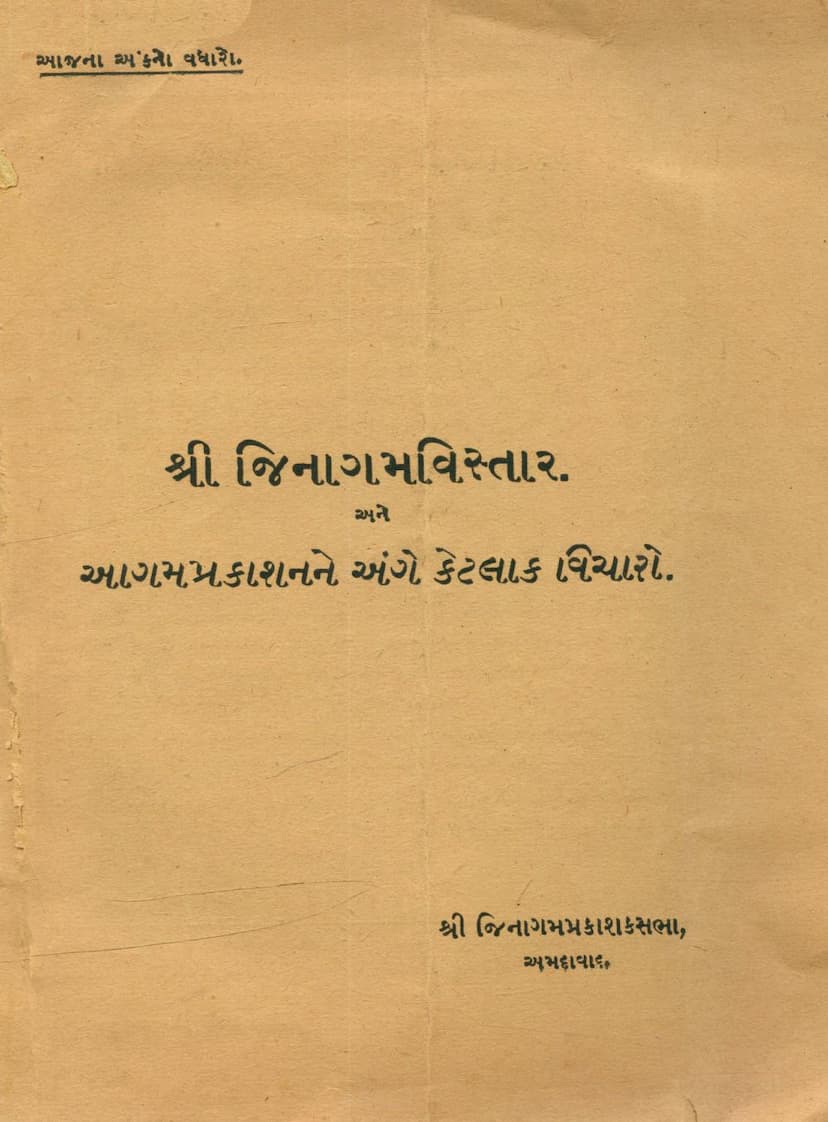Jinagam Vistar Ane Agam Prakashan Ange Vicharo
Added to library: September 2, 2025

Summary
This document, "Jinagam Vistar Ane Agam Prakashan Ange Vicharo" (Jainagamas Expansion and Thoughts on Agama Publication) published by the Jinagam Prakashak Sabha in Ahmedabad in 1913, outlines a significant project to publish all 45 Jain Agamas in their original Magadhi text, with Sanskrit commentaries and Gujarati translations.
The core purpose of the Jinagam Prakashak Sabha (Jainagamas Publishing Society) is to:
- Preserve and Disseminate Jain Agamas: The Sabha aims to publish the Jain Agamas, ensuring the original Magadhi text is accurately reproduced along with its Sanskrit commentaries and translations into the local language (Gujarati).
- Gather and Verify Manuscripts: They are actively seeking handwritten manuscripts of the Agamas from Jain monasteries, libraries, and individuals across all sects. The goal is to compare these manuscripts to create a pure and authentic version of the sacred texts.
- Initiate with Bhagvati Sutra: The first major project undertaken is the publication of the Bhagvati Sutra, a significant Agama. They are actively requesting its original sutras, commentaries by Shri Abhaydev Suri, and Gujarati translations (like the Laghuvritti by Shri Danashekhar Upadhyay).
- Broad Appeal and Support: The Sabha is reaching out to all Jain monks, scholars, caretakers of religious institutions, and the general Jain community for their support, whether by providing manuscripts, financial aid, or through their blessings.
- Addressing Concerns and Debates: A substantial portion of the document is dedicated to addressing various concerns and debates surrounding the publication of these sacred texts, particularly in the vernacular language. These include:
- Financial Needs: Recognizing the immense cost of such an undertaking (estimated at two lakhs of rupees over 25 years), they highlight the need for substantial financial support.
- Western Scholarship and Jainism: The document acknowledges the significant contributions of Western scholars like Buhler, Jacobi, and Weber in studying Jainism but emphasizes the need for indigenous scholarship and interpretation to accurately reflect Jain teachings.
- Vernacular Translations: A significant debate revolves around the translation of Agamas into Gujarati. Arguments are presented to justify this, emphasizing the need for broader accessibility and understanding, especially for monks and laypeople who may not be proficient in Magadhi and Sanskrit. They counter the argument that vernacular translations might lead to misinterpretation by highlighting the efforts of past Jain Acharyas who themselves provided vernacular commentaries.
- Relevance of Traditional Rules: The Sabha delves into the historical context of rules restricting certain Agamas to monks with specific ascetic practices or degrees of initiation. They argue that changing times and the need for broader knowledge necessitate a review and potential relaxation of these traditional restrictions, particularly for lay scholars and the wider community. They highlight how certain rules were implemented historically to counter the malpractices of Chaityavasis (temple dwellers).
- The Role of Lay Scholars: The document strongly advocates for the participation of educated lay scholars in translating and studying the Agamas. It argues that modern education equips them with critical thinking, historical analysis, and linguistic skills, which are essential for accurate translation and for defending Jainism against misinterpretations by Western scholars. They note that while monks possess deep philosophical knowledge, they may lack the modern analytical and linguistic skills required for contemporary scholarship.
- Countering Misinterpretations and Defending Jainism: A significant motivation is to counter the negative portrayals and misunderstandings of Jainism by some Western scholars. The Sabha aims to provide accurate, well-researched translations that can be used to refute these misinterpretations and present Jainism in its true light to the world, especially in an era of comparative religious studies.
- The Importance of Historical Accuracy: The document stresses that the Agamas are crucial for reconstructing the true history of Jainism, referencing the insights of prominent scholars like Keshavlal Harshadbhai Dhruv, who considers the Agamas the foundational texts for Jain history.
- The Need for Urgency: The Sabha expresses urgency in undertaking this project, fearing that as times change and modern education becomes more prevalent, the direct connection with traditional knowledge held by existing monks might diminish. They believe the current generation of monks possesses unique insights that should be captured and disseminated through publication.
- Practical Good vs. Sentimental Good: The document engages with the contemporary societal emphasis on "practical good" over "sentimental good." It argues that publishing the Agamas, which contain profound philosophical and scientific knowledge, ultimately leads to the greatest "practical good" by fostering true understanding and ethical conduct rooted in compassion.
- Future of Jainism and Scholarship: The Sabha expresses concern about the future of Jain scholarship if the Agamas are not properly published and translated. They anticipate that the growing influence of Rationalism and the increasing gap between traditional knowledge and modern intellectualism could lead to a decline in the understanding and practice of Jainism.
In essence, this document is a powerful manifesto for the comprehensive publication and scholarly study of Jain Agamas, driven by a deep commitment to preserving Jain heritage, ensuring accurate dissemination of knowledge, and safeguarding the religion's reputation in a rapidly changing world. It calls for collective effort and understanding to embark on this monumental task.